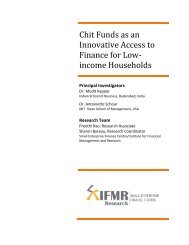Government of India Volume I: Analysis and Recommendations
Government of India Volume I: Analysis and Recommendations
Government of India Volume I: Analysis and Recommendations
You also want an ePaper? Increase the reach of your titles
YUMPU automatically turns print PDFs into web optimized ePapers that Google loves.
FUNCTIONS AND POWERS OF THE REGULATOR<br />
Table <strong>of</strong> <strong>Recommendations</strong> 4.1 Issuance <strong>of</strong> documents for public consultation<br />
The regulator will have to publish the following documents in the process <strong>of</strong> formulating new regulations:<br />
1. The draft regulations;<br />
2. The jurisdiction clause to identify the legal provision under which the proposed regulations are being made,<br />
<strong>and</strong> the manner in which the regulation is consistent with the principles in the concerned legislation(s). If<br />
the parent legislation does not specifically refer to the subject matter <strong>of</strong> regulations, the regulator will have<br />
to establish a logical connection between the subject matter <strong>and</strong> the empowering provision in the law. The<br />
document must contain explanation on how the regulation st<strong>and</strong>s vis-a-vis each <strong>of</strong> the relevant principles in<br />
the part(s) <strong>of</strong> the draft Code from which the powers are being drawn;<br />
3. A statement <strong>of</strong> the problem or market failure that the regulator seeks to address through the proposed regulations,<br />
which will be used to test the effectiveness with which the regulations address the stated problem.<br />
The statement must contain:<br />
◮ The principles governing the proposed regulations; <strong>and</strong><br />
◮ The outcome the regulator seeks to achieve through the regulation; <strong>and</strong><br />
4. An analysis <strong>of</strong> the costs <strong>and</strong> benefits <strong>of</strong> the proposed regulation. This is required because every regulatory<br />
intervention imposes certain costs on regulated entities <strong>and</strong> the system as a whole. The Commission recommends<br />
that regulations be drafted in a manner that minimises these compliance costs.<br />
In some cases where a pure numerical value based cost-benefit analysis is not possible, the regulator should<br />
provide the best possible analysis <strong>and</strong> reasoning for its choice <strong>of</strong> intervention.<br />
After publishing the above documents, the regulator will specify a designated time for receiving comments from the<br />
public on the regulations <strong>and</strong> the accompanying documents. The draft Code will ensure that the time period <strong>and</strong> the<br />
mode <strong>of</strong> participation specified by the regulator is appropriate to allow for widespread public participation.<br />
Table <strong>of</strong> <strong>Recommendations</strong> 4.2 Process after receiving public comments<br />
After the time specified for making comments has lapsed, it will be the responsibility <strong>of</strong> the regulator to:<br />
1. Publish all comments received;<br />
2. Provide reasoned general response to the comments received, <strong>and</strong> specific response to some comments if<br />
there is requirement stipulated in the draft Code for such response;<br />
3. Publish the review <strong>of</strong> the draft regulations carried out by the regulator’s advisory council;<br />
4. Have the final regulations approved by the board <strong>of</strong> the regulator. In the interests <strong>of</strong> transparency, the Commission<br />
recommends that deliberations <strong>and</strong> voting by the board members should be available publicly; <strong>and</strong><br />
5. Publish the final regulations.<br />
Table <strong>of</strong> <strong>Recommendations</strong> 4.3 Emergency regulation making<br />
In emergency situations the regulator would be empowered to pass regulations without following the consultation<br />
process <strong>and</strong> without conducting a cost-benefit analysis, subject to the following conditions:<br />
1. Regulations passed under this provision will lapse after a period <strong>of</strong> six months; <strong>and</strong><br />
2. The regulator must publish a reasoned order for using this power.<br />
the regulator to have the power to issue guidelines explaining the interpretation <strong>of</strong> the<br />
regulator <strong>of</strong> laws <strong>and</strong> regulations. The Commission believes that allowing the regulator<br />
to issue guidelines <strong>of</strong> this nature will constitute an important step in reducing uncertainty<br />
about the approach that the regulator may take.<br />
The mechanism <strong>of</strong> issuing guidelines should not be used to (in effect) make regulations<br />
without complying with the procedural requirements laid down for regulationmaking.<br />
For this reason, the draft Code clarifies that guidelines are merely recommendatory<br />
in nature <strong>and</strong> the violations <strong>of</strong> guidelines alone will not empower the regulator to<br />
initiate enforcement action against regulated entities. Table 4.4 shows the recommendations<br />
<strong>of</strong> the Commission in relation to issuance <strong>of</strong> guidelines.<br />
4.1.4. Accountability to the Parliament<br />
Since the power to issue regulations is a legislative power delegated by the Parliament to<br />
the regulators, regulations formulated by the regulator should be placed before the Par-<br />
FINANCIAL SECTOR LEGISLATIVE REFORMS COMMISSION 31



